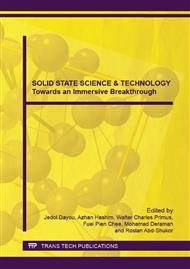[1]
M. Beecam, Global market review of automotive tyres-forecasts to 2014, Aroq Limited, UK. (2008).
Google Scholar
[2]
L. Li, S. Liu, and T. Zhu. Application of Activated Carbon derived from scrap tires for adsorption. J. Environmental Sciences. 22(2010) 1773-1280.
DOI: 10.1016/s1001-0742(09)60250-3
Google Scholar
[3]
O.S. Chan, W.H. Cheung, and G. McKay. Preparation and Characterisation of Demineralized Tyre derived activated carbon. Carbon. 49(2011) 4674-4687.
DOI: 10.1016/j.carbon.2011.06.065
Google Scholar
[4]
J. Shah, M.R. Jan, andF. Mabood. 2007. Catalytic conversion of waste tyres into valuable hydrocarbons. J. Polymer Environment. 15(2007)207-211.
DOI: 10.1007/s10924-007-0062-7
Google Scholar
[5]
A. Quek, R. Balasubramanian. Preparation and Charaterization of low energy post pyrolysis oxygenated tire char. J. Chemical Engineering. 170(2011)194-201.
DOI: 10.1016/j.cej.2011.03.053
Google Scholar
[6]
SIRIM Specification of powdered AC MS873: 1984. Standard and Industrial Research Institutes Malaysia. (1984).
Google Scholar
[7]
N.K. Hamadi, D.C. Xiao, M.M. Farid, and G.Q. Lu. Adsorption kinetics for the removal of chromium(VI) from aqueous solution by adsorbents derived from used tyres and sawdust. J. Chemical Engineering. 84(2001. ): 95-105.
DOI: 10.1016/s1385-8947(01)00194-2
Google Scholar
[8]
B.H. Hameed, L.H. Chin, and S. Rengaraj, Adsorption of 4-chlorophenol onto activated carbon prepared from rattan sawdust. Desalination. 225(2008): 185-198.
DOI: 10.1016/j.desal.2007.04.095
Google Scholar
[9]
A. Ahmadpour, D.D. Do. The preparation of active carbons from coal by chemical and physical activation. Carbon, 34(1996): 471-479.
DOI: 10.1016/0008-6223(95)00204-9
Google Scholar
[10]
E.L.K. Mui, W.H. Cheung, and G. McKay, Tyre char preparation from waste tyre rubber for dye removal from effluents. J. Hazard. Mater. 175 (2010) 151-158.
DOI: 10.1016/j.jhazmat.2009.09.142
Google Scholar
[11]
M.R. Nunes, G.M. Perez, L.F. Loguercio, E. W. Alves, N.L.V. Carreilo, J.L. Martin, and I.T.S. Garcia, Active Carbon Preparation from Treads of Tire for Removal in Waste Water. J. Brazil Chemical Science, 00(2011): 1-9.
DOI: 10.1590/s0103-50532011001100002
Google Scholar
[12]
K. Kaneko, 1994. Determination of pore size, and pore size distribution 1. Adsorbent and Catalyst. J. Membrane Science, 96(1994)59-89.
DOI: 10.1016/0376-7388(94)00126-x
Google Scholar
[13]
J. Wang, X. Yang, D. Wu, R. Fu, M.S. Dresselhaus, and .G. Dresselhaus, The Porous Structures of Activated Carbon Aerogels and Their effects on electrochemical performance. J. Power Source, 185 (2008) 589-594.
DOI: 10.1016/j.jpowsour.2008.06.070
Google Scholar
[14]
T.A. Saleh, V.K. Gupta, and A.A. Al-Saadi, Adsorption of lead ions from aqueous solution using porous carbon derived from rubber tires: Experimental and computational study. J. Colloid Interface Sci. 396(2013) 264–269.
DOI: 10.1016/j.jcis.2013.01.037
Google Scholar
[15]
F.W. Shaarani, and B.H. Hameed, Batch adsorption of 2, 4-dichlorophenol onto activated carbon derived from agricultural waste. Desalination. 255(2010): 159-164.
DOI: 10.1016/j.desal.2009.12.029
Google Scholar
[16]
K.Y. Foo, and B.H. Hameed, Mesoporous activated carbon from wood sawdust by K2CO3 activation using microwave heating. Bioresour. Technol. 111(2012) 425–432.
DOI: 10.1016/j.biortech.2012.01.141
Google Scholar


